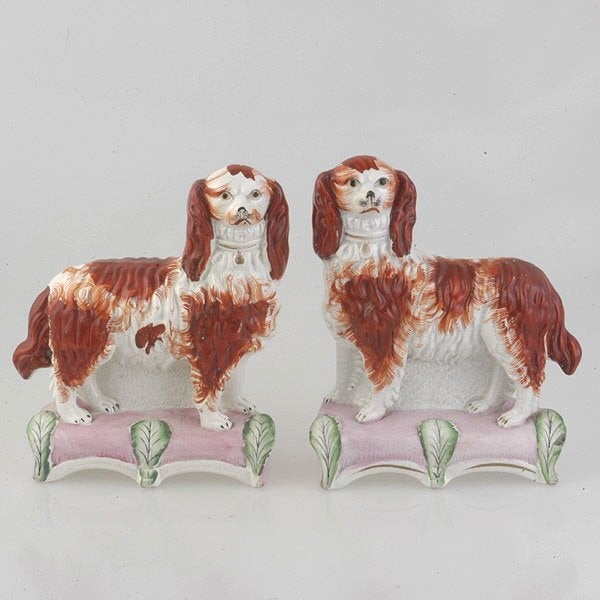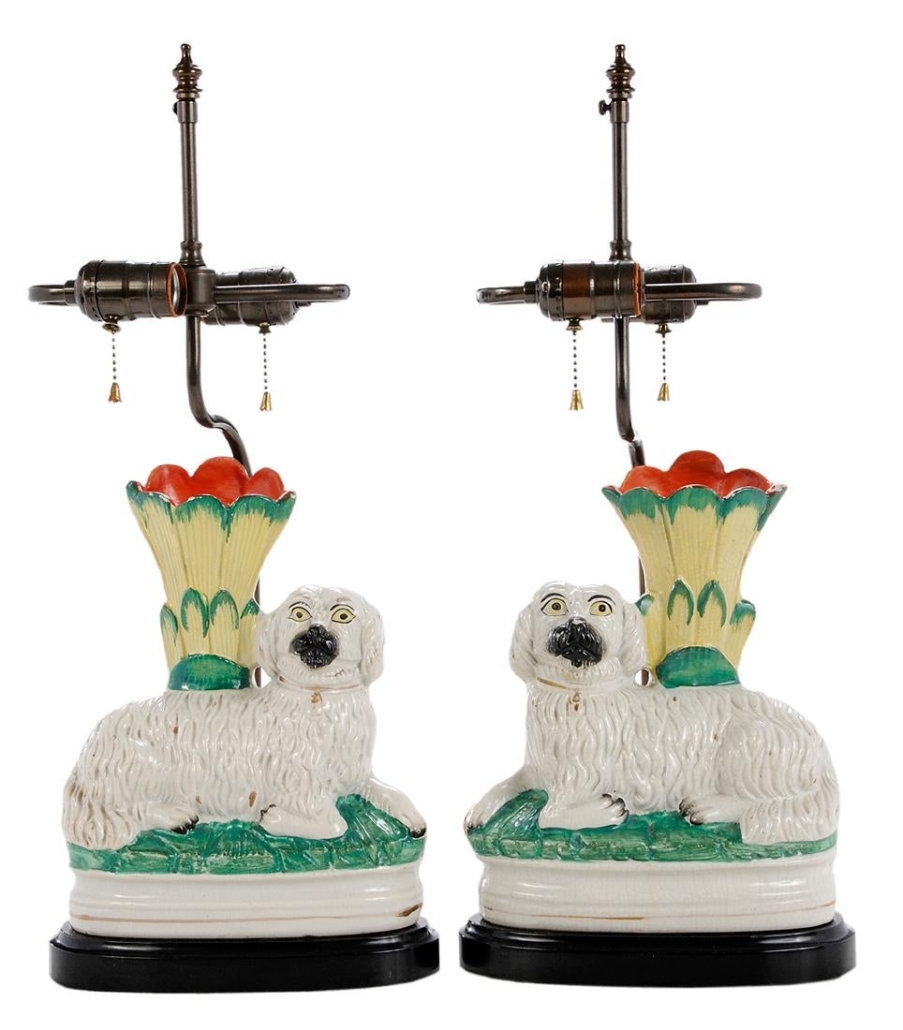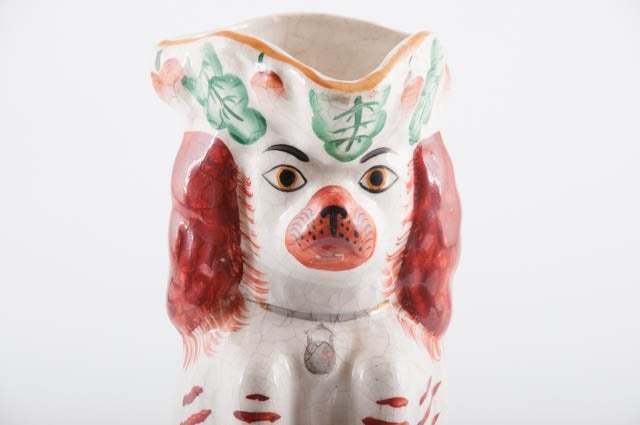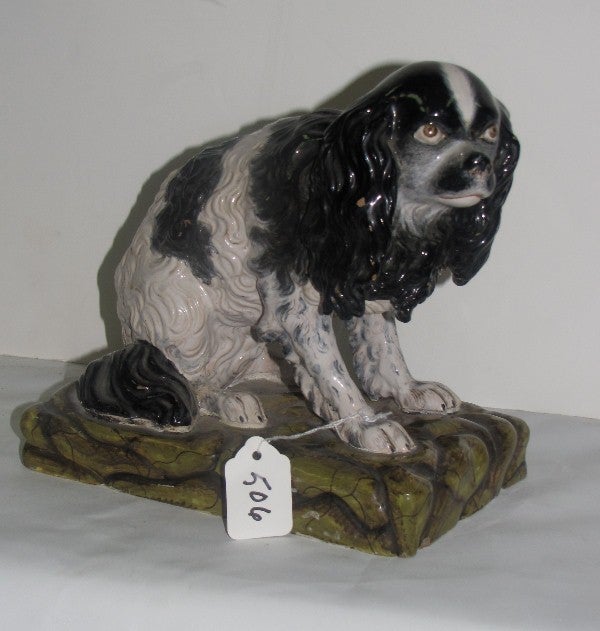
NEW YORK – Staffordshire pottery is beloved by collectors far beyond the shores of its native England. While potters in the Staffordshire region made many types of human and animal ceramic figures, perhaps none are more recognizable than their Victorian-era depictions of Cavalier King Charles spaniels (aka Staffordshire spaniels). They are also sometimes referred to as “hearth” or “mantel” spaniels, since they typically were displayed on fireplace mantels at the height of their popularity, circa 1840s-1890s. After the turn of the 20th century, their production quality seemed to decline, as did the number of collectors buying them, but they have never fallen out of favor.
Made simply and inexpensively by English pottery workers – some were even children – these spaniels were usually sold in matched pairs. At the height of their popularity, a pair could be seen standing guard over the mantel of most Victorian homes in Britain. They were hand-decorated, usually with the addition of a painted gold chain and locket around their necks. Some were made with flat backs, since they were frequently placed flush against the wall atop a mantel. Sizes varied from a few inches to a foot tall. The bottoms were often marked with a number from 1 to 6, a help to buyers who might want to collect sets in more than one size.

The appealing ceramic canines have been consistently collected over the past century and a half, but unfortunately there are reproductions in the marketplace. A distinctive feature, and one way to tell an original from a repro, is that even among matched pairs, the dogs are not identical. The size and location of their spots, among other differences, will vary slightly.
Staffordshire spaniels are the quintessential Victorian decoration, according to commentary on the website, The Antiques Almanac. “Of all the figures the potters created, sets of whimsical spaniels became the favorite, and came to epitomize Staffordshire ceramics.”
Antiques dealer Dora Connolly of Emmitsburg, Maryland, has long been a collector of ceramic spaniels, which she attributes to her fondness for the real-life versions. “I love them,” she said, noting her first Cavalier King Charles spaniel was named Percy after the main character in The Scarlet Pimpernel. Her second spaniel was named Winston Churchill. When it comes to Staffordshire versions, however, she has sold many and kept many others in a room dedicated to them in her home.

“You have to watch out for repros. [Fakers] have been able to reproduce even the crazing [a network of fine cracks on the surface of glazed ceramics],” she said. While experts can often tell the difference between the real and the unreal by assessing the heft of a piece, and examining its crazing and firing marks, new collectors may want to do some homework before making a purchase. There are many books and online reference sources worth consulting.
Connolly says some of her customers have been collecting for 20+ years. They will tell her they just don’t have room for one more dog, but rare and elusive examples are always tempting.

Toy spaniels were brought to England from the Orient by the Spanish, in the 16th century. The name “Cavalier King Charles spaniel” comes from King Charles II, who reportedly was so enamored of his palace dogs that he would take them everywhere he went, even playing with them while holding court. Many paintings of the king and his family members included one of more of his canine companions. But the ultimate sign of affection was Charles II’s Royal Decree declaring Cavalier King Charles spaniels had free reign of the kingdom and could enter any establishment they pleased. That decree has never been rescinded.
Queen Victoria was among the many royals who favored these spaniels and on the day of her coronation, she is said to have gone home afterwards to give her beloved King Charles spaniel, Dash, a bath. When Dash died, in 1840, it is said that Victoria herself dug his grave and had a marker placed on it that says:
Here lies
DASH
The favourite spaniel of Her Majesty Queen Victoria
In his 10th year
His attachment was without selfishness
His playfulness without malice
His fidelity without deceit
READER
If you would be beloved and die regretted
Profit by the example of
DASH
In the Staffordshire versions of Cavalier King Charles spaniels, there are several color patterns. They can come in black and tan, while ruby cavaliers are chestnut colored all over. Chestnut and white spaniels are known as Blenheims; and there is a tricolor spaniel, which is black and white with tan spots.

The Blenheims often have a chestnut spot at the top of their heads, and take their name after the Churchill ancestral home, Blenheim Palace, where John Churchill (Duke of Marlborough) raised dogs of this coloring. According to fanciful lore, while the Duke was on a crusade, the Duchess Sarah Churchill was at home anxiously waiting for his return with a pregnant spaniel on her lap. Supposedly she was petting or pressing on her dog’s head so much so that each puppy was born with what is today called the “Blenheim spot,” or “Duchess thumbprint” on its head.
Collectors can pick up Staffordshire spaniels fairly inexpensively today. Early examples in good condition and matched pairs can bring a few thousand dollars. For fans of these charming figures, it’s hard to stop at just one pair, and some collectors might find that once they get started, they might soon have a kennelful of charming guard dogs to protect their “palace.”
# # #


